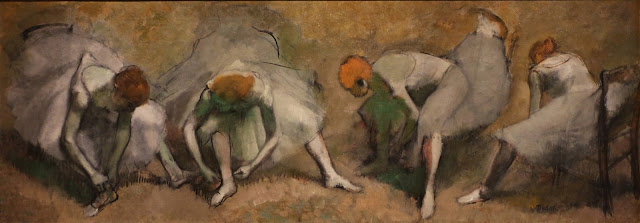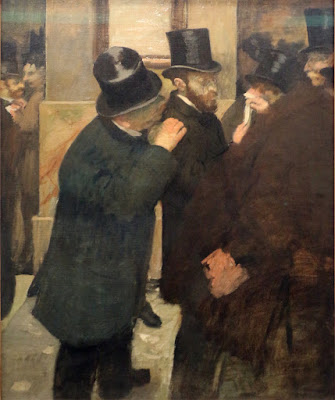 |
| Edgar Degas Dancer in Pink 1878 oil on canvas Art Institute of Chicago |
 |
| Edgar Degas Dancers ca. 1890-95 oil on canvas National Gallery, London |
 |
| Edgar Degas Dancers in Yellow (in the Wings) ca. 1874-76 oil on canvas Art Institute of Chicago |
 |
| Edgar Degas Frieze of Seated Dancers 1895 oil on canvas Cleveland Museum of Art, Ohio |
 |
| Edgar Degas Frieze of Seated Dancers (detail) 1895 oil on canvas Cleveland Museum of Art, Ohio |
 |
| Edgar Degas Dance Studio of the Opéra on rue Le Peletier 1872 oil on canvas Musée d'Orsay, Paris |
 |
| Edgar Degas Dance Studio of the Opéra on rue Le Peletier (detail) 1872 oil on canvas Musée d'Orsay, Paris |
 |
| Edgar Degas Mademoiselle Marie Dihau at the Piano ca. 1869-72 oil on canvas Musée d'Orsay, Paris |
 |
| Edgar Degas Henri Degas and his niece Lucie Degas (the artist's uncle and cousin) ca. 1875-76 oil on canvas Art Institute of Chicago |
 |
| Edgar Degas Portrait after a Costume Ball (Madame Dietz-Monnin) 1879 pastel and distemper on canvas Art Institute of Chicago |
 |
| Edgar Degas Hélène Rouart in her Father's Study ca. 1886 oil on canvas National Gallery, London |
 |
| Edgar Degas Portrait of Elena Carafa 1875 oil on canvas National Gallery, London |
 |
| Edgar Degas Portrait of the cellist Pilet ca. 1868-69 oil on canvas Musée d'Orsay, Paris |
 |
| Edgar Degas Portraits at the Stock Exchange ca. 1878-79 oil on canvas Musée d'Orsay, Paris |
 |
| Edgar Degas The Pedicurist 1873 oil on paper, mounted on canvas Musée d'Orsay, Paris |
Edgar Degas (1834-1917) – Though his subjects and his involvement in the promotion of Impressionism marked him out as a member of the group, he did not embrace their priorities. He painted a few subtle landscapes, but was impatient with the doctrine that painting was to be done out-of-doors and preferably at one go. His feeling for modern subjects and for colour and texture as major factors in painting fused with convictions about the organization of images that were essentially classical while also reflecting new concepts of space and vision derived from photography and Japanese prints. . . . Degas's fascination with inelegant, commonplace subjects marks him out as dramatically modern, breaking once and for all the old link between serious art and high-minded, time-honoured themes. He left over 2000 oils and pastels.
– excerpted from the Yale Dictionary of Art and Artists (2000) by Erika Langmuir and Norbert Lynton